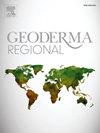Tracking pedogenic carbonate formation and alkalinity migration in agricultural soils amended with crushed wollastonite ore – Evidence from field trials in Southwestern Ontario
IF 3.3
2区 农林科学
Q2 SOIL SCIENCE
引用次数: 0
Abstract
Considered a well-known carbon sequestration method, terrestrial enhanced rock weathering (ERW) involves the application of crushed silicate-bearing minerals to urban and agricultural soils. Once dissolved in a soil–water system, alkaline minerals adjust the pH in a range favorable for pedogenic carbonate formation and, hence, atmospheric carbon drawdown. As a fast-weathering Ca-rich mineral, wollastonite is recognized as a primary candidate for this process. Although previous studies have demonstrated the potential of wollastonite to sequester carbon in croplands, no study has investigated the fate of wollastonite over the vertical profile of soil. Furthermore, no studies have investigated changes in the elemental composition of soils due to wollastonite amendment at the field scale. The present study presents the results of multiyear sample collection from different layers (0–15, 15–30, and 30–60 cm) of agricultural soil amended with wollastonite in Woodstock, Ontario, Canada. The impact of initial soil pH on pedogenic carbonate formation was also investigated through the inclusion of two more field trials (Thorndale and Dawn-Euphemia, Ontario). The results indicated that wollastonite addition increased the inorganic carbon pool of the soil at a rate as fast as 0.55 t CO2/(ha·month) at higher (20 t/ha) wollastonite dosages, and with efficiencies reaching up to 0.42 t CO2/t wollastonite (as CO32-). Elemental composition analyses (WDXRF) revealed increases in the Ca (0.05–0.32 %) and Mg (0.01–0.02 %) contents in the amended soils that either were inferior to the theoretical amendment change, suggesting migration of weathering products to deeper layers, or in some cases similar and thus correlating with pedogenic carbonate retention in surficial layers. The implications of composite sampling and year-over-year comparisons on the estimated uncertainty from statistical analysis (hierarchical permutation test of the Wilcoxon signed-rank test) is discussed. This study concludes that carbonate formation is not limited to surficial layers and that deeper layers also need to be taken into account when estimating carbon capture due to ERW practices.

用碎硅灰石矿修正的农业土壤中成土碳酸盐形成和碱度迁移的跟踪——来自安大略省西南部野外试验的证据
陆地增强岩石风化(ERW)是一种众所周知的固碳方法,它将破碎的含硅酸盐矿物应用于城市和农业土壤。一旦溶解在土壤-水系统中,碱性矿物质就会将pH值调整到一个有利于成土碳酸盐形成的范围,从而降低大气中的碳含量。硅灰石作为一种快速风化的富钙矿物,被认为是这一过程的主要候选者。虽然以前的研究已经证明了硅灰石在农田中固碳的潜力,但没有研究调查过硅灰石在土壤垂直剖面上的命运。此外,还没有在野外尺度上研究硅灰石改性对土壤元素组成的影响。本研究介绍了在加拿大安大略省伍德斯托克市用硅灰石改性的农业土壤的不同层(0 - 15,15 - 30和30-60 cm)多年样品收集的结果。通过另外两个实地试验(Thorndale和Dawn-Euphemia, Ontario),还研究了初始土壤pH值对成土碳酸盐形成的影响。结果表明,在硅灰石添加量较高(20 t/ha)时,土壤无机碳库的增加速率高达0.55 t CO2/(ha·月),效率最高可达0.42 t CO2/t硅灰石(以CO32-计)。元素组成分析(WDXRF)显示,修正后的土壤中Ca(0.05 ~ 0.32%)和Mg(0.01 ~ 0.02%)含量的增加低于理论修正的变化,表明风化产物向深层迁移,或者在某些情况下类似,因此与表层成土碳酸盐保留有关。讨论了复合抽样和逐年比较对统计分析(Wilcoxon符号秩检验的分层排列检验)估计不确定性的影响。这项研究的结论是,碳酸盐的形成并不局限于表层,在估计由于ERW实践造成的碳捕获时,也需要考虑更深的层。
本文章由计算机程序翻译,如有差异,请以英文原文为准。
求助全文
约1分钟内获得全文
求助全文
来源期刊

Geoderma Regional
Agricultural and Biological Sciences-Soil Science
CiteScore
6.10
自引率
7.30%
发文量
122
审稿时长
76 days
期刊介绍:
Global issues require studies and solutions on national and regional levels. Geoderma Regional focuses on studies that increase understanding and advance our scientific knowledge of soils in all regions of the world. The journal embraces every aspect of soil science and welcomes reviews of regional progress.
 求助内容:
求助内容: 应助结果提醒方式:
应助结果提醒方式:


